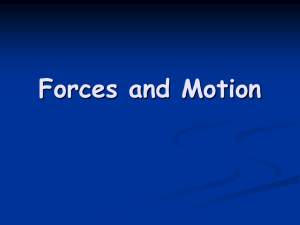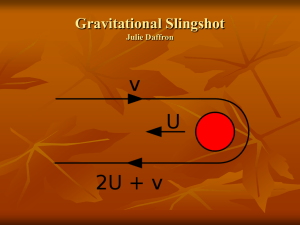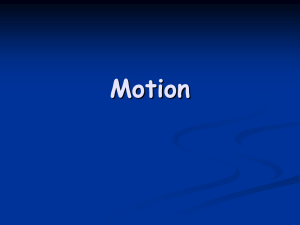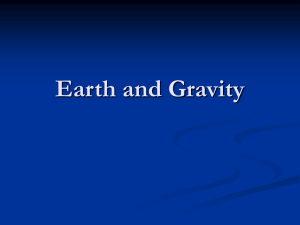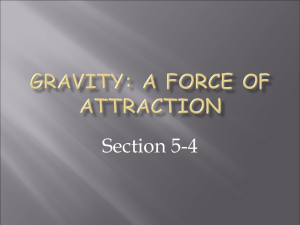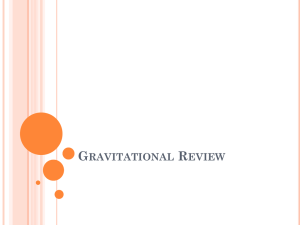Gravity: A Force of Attraction
advertisement
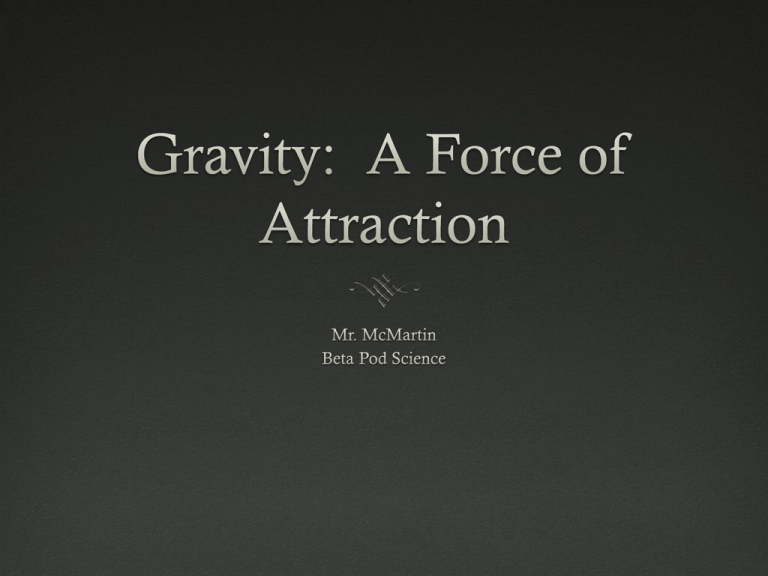
Question: Have you ever seen a video of astronauts on the moon? They bounce around like beach balls even though they wear big, bulky spacesuits. Why is leaping on the moon easier than leaping on earth? Gravity: the force of attraction between objects that is due to their masses. The force of gravity can change the motion of an object by changing it’s speed, direction or both. The Effects of Gravity on Matter Remember: All matter has mass. Gravity is a result of mass. Therefore, matter is affected by gravity. Because all matter is affected by gravity, that means all objects experience an attraction toward all other objects. Right now, because of gravity, you are being pulled toward this book, your pencil, and every other object around you. They are also being pulled toward one another. Why don’t you feel gravitational pull towards all objects around you? The reason you don’t feel the attraction between you and all other objects around you is that the mass of most objects is too small to cause a force large enough to move objects toward each other. The earth is what causes those objects to seem like they have no attraction to you at all. The size of Earth’s gravitational force Compared with all objects around you, Earth has a huge mass. Therefore, Earth’s gravitational force is very large. You must apply forces to overcome Earth’s gravitational force any time you lift objects or even parts of your body. Earth’s gravitational force pulls everything toward the center of Earth. This is why objects that are dropped fall to the ground instead of moving together or toward you. Newton and the Study of Gravity Legend has it that Isaac Newton answered the following two questions (questions that hadn’t been answered up until this time) while watching an apple drop: Why do objects fall toward Earth? What keeps the planets moving in the sky? The Core of Newton’s Idea Newton knew that unbalanced forces are needed to change the motion of objects. He concluded that an unbalanced force on the apple made the apple fall. From this he reasoned that an unbalanced force on the moon kept the moon moving circularly around Earth. He proposed that these two forces are actually the same force, the force of attraction called “gravity.” The Birth of a Law Newton summarized his ideas about gravity in a law now known as the “law of universal gravitation.” This law describes the relationships between gravitational force, mass, and distance. The law is “universal” because it applies to all objects in the universe. The Law of Universal Gravitation All objects in the universe attract each other through gravitational force. The size of the force depends on: the masses of the objects the distance between the objects. Gravitational Force Increases as Mass Increases The cat and the elephant: The elephant has a larger mass than the cat. Therefore, the amount of gravity between the elephant and the earth is greater than the cat and the earth. Because of the effect of gravity on their masses, the cat is much easier to pick up. There is also gravitational pull between the cat and the elephant, but the mass of the elephant is so much smaller than the earth’s mass, their gravitational pull is much smaller. This phenomena shows why astronauts bounce on the moon and not on earth. The moon’s mass is much less than earth’s mass so it’s gravitational pull is much less allowing the astronauts to bounce more. Gravitational Force Decreases as Distance Increases You jump up and land on the ground because of the gravitational force between you and earth. The sun is 300,000 times more massive than earth… so why doesn’t the sun’s gravitational force affect you more than earth’s does? The reason is that the sun is so far away. We are about 150 million kilometers away from the sun. If you could stand on it, you would find it impossible to move AT ALL. Weight as a Measure of Gravitational Force Gravity is a force of attraction between objects. Weight: is a measure of the gravitational force on an object. Usually you hear weight referring to the Earth’s gravitational pull on an object, but weight can also be a measure of the gravitational force exerted on objects by the moon or other planets. The Differences Between Weight and Mass Weight is related to mass, but they are not the same. Weight changes when gravitational force changes. Mass: the amount of matter in an object. The amount of mass in an object does not change. This can get confusing… because weight and mass are “constant” on Earth, the terms weight and mass are often used to mean the same thing. Be sure you know the difference!!! Units of Weight and Mass You have learned that the SI unit of force is a newton (n). Gravity is a force, and wieght is a measure of gravity. So… weight is also measured in newtons (n). The SI unit of mass is the kilogram (kg). Mass is often measured in grams and milligrams as well. On earth, a 100g object, such as the apple shown in Figure 7, weighs about 1 N. Why Bathroom Scales Confuse Us When you use a bathroom scale, you are measuring the gravitational force between your body and Earth. So you are measuring your weight, which should be given in newtons. However, many bathroom scales have units of pounds and kilograms instead of newtons. Thus, people sometimes mistakenly think that the kilogram (like the pound) is a unit of weight.

